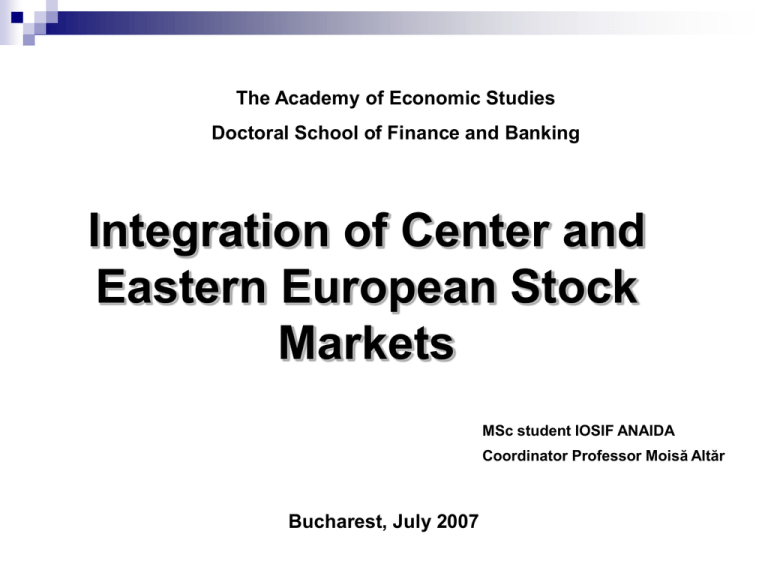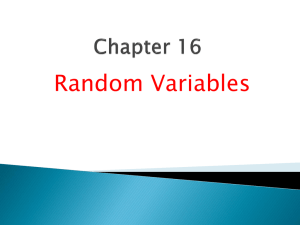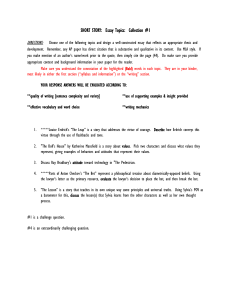Volatility
advertisement

The Academy of Economic Studies Doctoral School of Finance and Banking Integration of Center and Eastern European Stock Markets MSc student IOSIF ANAIDA Coordinator Professor Moisă Altăr Bucharest, July 2007 Dissertation paper outline The integration of the emerging stock markets The aims of the paper Empirical studies concerning stock markets integration The Data Testing the cointegration Testing the correlation Conclusions References Different approaches Bekaert and Harvey (1997) – market liberalization increase the correlation between local market returns and the world market but do not drive up local volatility . Forbs and Rigobon (1999) – there was no contagion during the euroAsia crises in 1997, the Mexican peso collapse in 1994 and in the US stock market crash in 1987. High market co-movements during these periods where a continuation of strong cross-market linkages Egert and Kocenda (2005) – there are no robust cointegration relationship between emerging and developed markets. But there are short-term spillover effects in terms of stock returns and stock price volatility. Cappielo, G’erard, Kadareja and Manganelli (2006) – larger new EU member state exhibit a strong comovements between themselves and with the euro area. Form the smaller countries only Estonia and Cyprus show integration bough with the euro zone and the block of large economies. The Data 10000 Initial data series: Bucharest Exchange Trading index (BET), 1800 1600 8000 1400 1200 6000 1000 4000 800 600 2000 Prague Exchange index (PX), Warsaw Exchange index (WIG20), 400 0 200 2001 2002 2003 2004 2005 2006 2001 2002 2003 2004 2005 2006 2005 2006 2005 2006 PX BET 3600 1600 3200 1400 1200 2800 1000 Bulgarian Exchange index (SOFIX), Budapest Stock Index (BUX) Austrian Traded Index (ATX). 2400 800 2000 600 1600 400 1200 200 0 800 2001 2002 2003 2004 2005 2001 2006 2002 2003 2004 SOFIX W IG 28000 5000 24000 4000 20000 3000 Time length: 20.10.2000 – 04.03.2007 16000 2000 12000 1000 8000 4000 0 2001 2002 2003 2004 BUX 2005 2006 2001 2002 2003 2004 ATX The Cointegration analyses Verify stationarity of series using ADT, Phillips-Perron and KPSS tests: the series are not stationary in level but is stationary in first difference Check the cointegration relationship between the variables using the Engle Granger residual based cointegration method: X t 1 i 1iYi ,t t n Estimate residuals series for each regression. Verify the stationarity of the residual series using ADF and PP tests. Comparing the test statistic with the critical values estimated by Engle and Yoo. Engle-Granger cointegration test Variables ADF PP ATX -3.420593* -3.509189* BET -3.648032* -3.380750* BUX -4.589758* -4.270524* PX -5.088.152 -4.560678* WIG -3.674414* -3.486132* SOFIX -2.972781* -3.215374* Cointegration analysis Johansen method in a VAR framework Select numbers of lags to include in the VAR using the Akaike informational criterion Check VAR stability yt yt k 1yt 1 2 yt2 ... k 1yt ( k 1) t Cointegration - conclusions The residuals are not stationary, the value of t statistic is higher then the critical value The Johansen method – the test statistic is smaller then the critical values There is no cointegration relationship between the series. Johansen cointegration test-eigenvalue trace No.of Eigenvalue Test statistic 5% critical 1% critical cointegration value value None 0.020503 79.57171 94.15 103.18 At most 1 0.011279 49.57410 68.52 76.07 At most 2 0.010257 33.14909 47.21 54.46 At most 3 0.007897 18.22059 29.68 35.65 At most 4 0.004609 6.740067 15.41 20.04 At most 5 3.56E-05 0.051499 3.76 6.65 Johansen cointegration test-eigenvalue max No. of Eigenvalue Test statistic 5% critical 1% critical cointegration value value None 0.020503 29.99762 39.37 45.10 At most 1 0.011279 16.42501 33.46 38.77 At most 2 0.010257 14.92850 27.07 32.24 At most 3 0.007897 11.48052 20.97 25.52 At most 4 0.004609 6.688568 14.07 18.63 At most 5 3.56E-05 0.051499 3.76 6.65 The correlation analysis for the returns Calculating the returns: dl_index Correlation matrix for returns ATX BET BUX PX SOFIX WIG ATX 1.000000 0.037999 0.445384 0.487496 -0.014321 0.375169 BET 0.037999 1.000000 0.016596 -0.021922 0.016283 0.017652 BUX 0.445384 0.016596 1.000000 0.545900 0.027081 0.536316 PX 0.487496 -0.021922 0.545900 1.000000 0.044288 0.497050 SOFIX -0.014321 0.016283 0.027081 0.044288 1.000000 -0.003174 WIG 0.375169 0.017652 0.536316 0.497050 -0.003174 1.000000 The correlation analysis Verify the short-term interaction between returns using Granger causality test: Yt 1 i 1i Yt 1 i 1 i X t 1 t k k X t 1 i 1i X t 1 i 1 i Yt 1 t k Dependent variable ATX WIG BUX PX BET SOFIX k ATX 0.5379 0.0954 0.6382 0.6461 0.3594 Granger causality test for returns Lags of variable WIG BUX PX BET 0.8864 0.7603 0.0710 0.9771 0.3632 0.7832 0.7919 0.4349 0.7776 0.8995 0.5534 0.5316 0.1943 0.0311 0.8891 0.2188 0.2729 0.1126 0.8735 0.4195 SOFIX 0.3061 0.8956 0.8116 0.3178 0.5890 - Lag length criteria suggests a specification including 1 lag Choosing the order of the variables using the F-test, market capitalization and the efficiency of the market: ATX, WIG, PX, BUX, BET, SOFIX. Verify the sign and proportion of the spillover between the returns using the impulse response and variance decomposition. The response of returns to shocks applied on the other markets Response to Cholesky One S.D. Innovations ± 2 S.E. Response of D_ATX to D_ATX Response of D_ATX to D_WIG Response of D_ATX to D_BUX Response of D_ATX to D_PX Response of D_ATX to D_BET Response of D_ATX to D_SOFIX .012 .012 .012 .012 .012 .012 .010 .010 .010 .010 .010 .010 .008 .008 .008 .008 .008 .008 .006 .006 .006 .006 .006 .006 .004 .004 .004 .004 .004 .004 .002 .002 .002 .002 .002 .000 .000 .000 .000 .000 .000 -.002 -.002 -.002 -.002 -.002 -.002 1 2 3 1 Response of D_WIG to D_ATX 2 3 1 Response of D_WIG to D_WIG 2 3 1 Response of D_WIG to D_BUX 2 3 .002 1 Response of D_WIG to D_PX 2 3 Response of D_WIG to D_BET 1 .016 .016 .016 .016 .016 .016 .012 .012 .012 .012 .012 .012 .008 .008 .008 .008 .008 .008 .004 .004 .004 .004 .004 .004 .000 .000 .000 .000 .000 -.004 -.004 1 2 3 -.004 1 Response of D_BUX to D_ATX 2 3 -.004 1 Response of D_BUX to D_WIG 2 3 Response of D_BUX to D_BUX 2 3 -.004 1 Response of D_BUX to D_PX 2 3 Response of D_BUX to D_BET 1 .012 .012 .012 .012 .012 .008 .008 .008 .008 .008 .008 .004 .004 .004 .004 .004 .004 .000 1 2 3 .000 1 Response of D_PX to D_ATX 2 3 .000 1 Response of D_PX to D_WIG 2 3 .000 1 Response of D_PX to D_BUX 2 3 2 3 1 Response of D_PX to D_BET .012 .012 .012 .012 .012 .010 .010 .010 .010 .010 .010 .008 .008 .008 .008 .008 .008 .006 .006 .006 .006 .006 .006 .004 .004 .004 .004 .004 .004 .002 .002 .002 .002 .002 .000 .000 .000 .000 .000 .000 -.002 -.002 -.002 -.002 -.002 -.002 2 3 1 Response of D_BET to D_ATX 2 3 1 Response of D_BET to D_WIG 2 3 1 Response of D_BET to D_BUX 2 3 2 3 Response of D_BET to D_BET 1 .016 .016 .016 .016 .016 .012 .012 .012 .012 .012 .012 .008 .008 .008 .008 .008 .008 .004 .004 .004 .004 .004 .004 .000 .000 .000 .000 .000 -.004 1 2 3 Response of D_SOFIX to D_ATX -.004 1 2 3 Response of D_SOFIX to D_WIG -.004 1 2 3 Response of D_SOFIX to D_BUX 2 3 Response of D_SOFIX to D_PX -.004 1 2 3 Response of D_SOFIX to D_BET 1 .024 .024 .024 .024 .024 .020 .020 .020 .020 .020 .020 .016 .016 .016 .016 .016 .016 .012 .012 .012 .012 .012 .012 .008 .008 .008 .008 .008 .008 .004 .004 .004 .004 .004 .000 .000 .000 .000 .000 .000 -.004 -.004 -.004 -.004 -.004 -.004 2 3 1 2 3 1 2 3 1 2 3 2 3 Response of D_SOFIX to D_SOFIX .024 1 3 .000 -.004 1 2 Response of D_BET to D_SOFIX .016 -.004 3 .002 1 Response of D_BET to D_PX 2 Response of D_PX to D_SOFIX .012 1 3 .000 1 Response of D_PX to D_PX 2 Response of D_BUX to D_SOFIX .012 .000 3 .000 -.004 1 2 Response of D_WIG to D_SOFIX .004 1 2 3 1 2 3 Variance decomposition for the returns The initial shock in the returns works through the system in about 3 days None of the emergent markets influence the Austrian returns, but changes in returns on the three larger emergent stock markets are due to changes in the Austrian returns The three larger emergent markets: Poland, Czech Republic and Hungary are correlated between themselves in terms of returns BET and SOFIX returns seem uninfluenced by the movements of the other returns. Days ahead 1 2 3 Days ahead 1 2 3 Days ahead 1 2 3 Days ahead 1 2 3 Days ahead 1 2 3 Days ahead 1 2 3 Variance decomposition for ATX returns D_ATX D_WIG D_PX D_BUX D_BET 100.0000 0.000000 0.000000 0.000000 0.000000 99.59105 0.044013 0.286347 0.007451 3.33E-06 99.58768 0.044011 0.287208 0.007801 0.000799 Variance decomposition for WIG returns D_ATX D_WIG D_PX D_BUX D_BET 14.17161 85.82839 0.000000 0.000000 0.000000 14.10401 85.81295 0.021019 0.056347 0.004508 14.10415 85.81132 0.021926 0.056702 0.004724 Variance decomposition for PX returns D_ATX D_WIG D_PX D_BUX D_BET 23.69439 11.67964 64.62597 0.000000 0.000000 23.59788 11.63133 64.56473 0.023212 0.115084 23.59706 11.63074 64.56074 0.023219 0.120464 Variance decomposition for BUX returns D_ATX D_WIG D_PX D_BUX D_BET 19.80737 15.93645 5.813288 58.44290 0.000000 20.07214 15.91336 5.791510 58.21816 0.000972 20.07180 15.91375 5.792217 58.21720 0.001113 Variance decomposition for BET returns D_ATX D_WIG D_PX D_BUX D_BET 0.149843 0.007663 0.243116 0.016866 99.58251 0.156055 0.222483 0.295727 0.019366 99.28715 0.155925 0.237918 0.299797 0.019994 99.26612 Variance decomposition for SOFIX returns D_ATX D_WIG D_PX D_BUX D_BET 0.020217 0.001275 0.311388 0.063885 0.043412 0.042319 0.011096 0.330570 0.218532 0.092179 0.044023 0.011096 0.330957 0.219286 0.092734 D_SOFIX 0.000000 0.071139 0.072503 D_SOFIX 0.000000 0.001168 0.001177 D_SOFIX 0.000000 0.067762 0.067778 D_SOFIX 0.000000 0.003862 0.003918 D_SOFIX 0.000000 0.019224 0.020247 D_SOFIX 99.55982 99.30530 99.30190 Methods in obtaining returns volatility Obtained variances series for returns using GARCH(1,1) method - the mean equation: y t y t 1 t - the conditional variance equation: t2 t21 t21 Using a EGARCH(1,1,1) method to estimate variance for SOFIX returns Conditional variance equation for the EGARCH: ln( t2 ) ln( t21 ) t 1 t 1 2 2 2 t 1 t 1 Advantages in using a EGARCH method: - the coefficients can be negative because ln( t2 ) is modeled. - the asymmetry of the EGARCH model capture the leverage effect. Volatility - the correlation analyze Verify stationarity of the variance using the ADF and PP tests, the series are stationary at any significance level. Check the relation between the series using the matrix correlation and Granger Causality test. Correlation matrix for volatiles ATX BET BUX PX SOFIX ATX BET BUX PX SOFIX WIG Dependent variable ATX BET BUX SOFIX PX WIG WIG 1.000000 -0.075787 0.461381 0.522018 -0.046720 0.179787 -0.075787 1.000000 0.062745 -0.035368 -0.033744 -0.166919 0.461381 0.062745 1.000000 0.675333 0.038740 0.332519 0.522018 -0.035368 0.675333 1.000000 0.106245 0.347898 -0.046720 -0.033744 0.038740 0.106245 1.000000 0.366838 0.179787 -0.166919 0.332519 0.347898 0.366838 1.000000 Granger causality test for variance Lags of variable ATX BET BUX SOFIX PX 0.5589 0.6707 - WIG 0.4989 0.1782 0.8455 0.8701 0.0259 0.3360 0.1367 0.0946 0.0401 0.9509 0.3882 0.0285 0.3143 0.7626 0.6825 0.9919 0.3906 0.2474 - 0.1647 0.9934 0.1262 0.1319 0.7174 0.9941 0.2192 0.3314 0.4108 0.8961 - Impulse response for volatility Response to Cholesky One S.D. Innovations ± 2 S.E. Response of D_ATXVARIANCE to D_ATXVARIANCE Response of D_ATXVARIANCE to D_WIGVARIANCE Response of D_ATXVARIANCE to D_BUXVARIANCE Response of D_ATXVARIANCE to D_PXVARIANCE Response of D_ATXVARIANCE to D_BETVARIANCE Response of D_ATXVARIANCE to D_SOFIXVARIANCE .00006 .00006 .00006 .00006 .00006 .00006 .00005 .00005 .00005 .00005 .00005 .00005 .00004 .00004 .00004 .00004 .00004 .00004 .00003 .00003 .00003 .00003 .00003 .00003 .00002 .00002 .00002 .00002 .00002 .00002 .00001 .00001 .00001 .00001 .00001 .00001 .00000 .00000 .00000 .00000 .00000 .00000 -.00001 -.00001 -.00001 -.00001 -.00001 -.00001 25 50 75 100 125 150 175 200 25 50 75 100 125 150 175 200 25 50 75 100 125 150 175 200 25 50 75 100 125 150 175 200 25 50 75 100 125 150 175 200 25 50 75 100 125 150 175 200 Response of D_WIGVARIANCE to D_ATXVARIANCE Response of D_WIGVARIANCE to D_WIGVARIANCE Response of D_WIGVARIANCE to D_BUXVARIANCE Response of D_WIGVARIANCE to D_PXVARIANCE Response of D_WIGVARIANCE to D_BETVARIANCE Response of D_WIGVARIANCE to D_SOFIXVARIANCE .000016 .000016 .000016 .000016 .000016 .000016 .000012 .000012 .000012 .000012 .000012 .000012 .000008 .000008 .000008 .000008 .000008 .000008 .000004 .000004 .000004 .000004 .000004 .000004 .000000 .000000 .000000 .000000 .000000 .000000 -.000004 -.000004 -.000004 -.000004 -.000004 -.000004 -.000008 -.000008 25 50 75 100 125 150 175 200 -.000008 25 50 75 100 125 150 175 200 -.000008 25 50 75 100 125 150 175 200 -.000008 25 50 75 100 125 150 175 200 -.000008 25 50 75 100 125 150 175 200 25 50 75 100 125 150 175 200 Response of D_BUXVARIANCE to D_ATXVARIANCE Response of D_BUXVARIANCE to D_WIGVARIANCE Response of D_BUXVARIANCE to D_BUXVARIANCE Response of D_BUXVARIANCE to D_PXVARIANCE Response of D_BUXVARIANCE to D_BETVARIANCE Response of D_BUXVARIANCE to D_SOFIXVARIANCE .000025 .000025 .000025 .000025 .000025 .000025 .000020 .000020 .000020 .000020 .000020 .000020 .000015 .000015 .000015 .000015 .000015 .000015 .000010 .000010 .000010 .000010 .000010 .000010 .000005 .000005 .000005 .000005 .000005 .000005 .000000 .000000 .000000 .000000 .000000 -.000005 -.000005 25 50 75 100 125 150 175 200 -.000005 25 50 75 100 125 150 175 200 -.000005 25 50 75 100 125 150 175 200 .000000 -.000005 25 50 75 100 125 150 175 200 -.000005 25 50 75 100 125 150 175 200 25 50 75 100 125 150 175 200 Response of D_PXVARIANCE to D_ATXVARIANCE Response of D_PXVARIANCE to D_WIGVARIANCE Response of D_PXVARIANCE to D_BUXVARIANCE Response of D_PXVARIANCE to D_PXVARIANCE Response of D_PXVARIANCE to D_BETVARIANCE Response of D_PXVARIANCE to D_SOFIXVARIANCE .00005 .00005 .00005 .00005 .00005 .00005 .00004 .00004 .00004 .00004 .00004 .00004 .00003 .00003 .00003 .00003 .00003 .00003 .00002 .00002 .00002 .00002 .00002 .00002 .00001 .00001 .00001 .00001 .00001 .00001 .00000 .00000 .00000 .00000 .00000 -.00001 -.00001 25 50 75 100 125 150 175 200 -.00001 25 50 75 100 125 150 175 200 -.00001 25 50 75 100 125 150 175 200 .00000 -.00001 25 50 75 100 125 150 175 200 -.00001 25 50 75 100 125 150 175 200 25 50 75 100 125 150 175 200 Response of D_BETVARIANCE to D_ATXVARIANCE Response of D_BETVARIANCE to D_WIGVARIANCE Response of D_BETVARIANCE to D_BUXVARIANCE Response of D_BETVARIANCE to D_PXVARIANCE Response of D_BETVARIANCE to D_BETVARIANCE Response of D_BETVARIANCE to D_SOFIXVARIANCE .00012 .00012 .00012 .00012 .00012 .00012 .00010 .00010 .00010 .00010 .00010 .00010 .00008 .00008 .00008 .00008 .00008 .00008 .00006 .00006 .00006 .00006 .00006 .00006 .00004 .00004 .00004 .00004 .00004 .00004 .00002 .00002 .00002 .00002 .00002 .00000 .00000 .00000 .00000 .00000 .00000 -.00002 -.00002 -.00002 -.00002 -.00002 -.00002 25 50 75 100 125 150 175 200 25 50 75 100 125 150 175 200 25 50 75 100 125 150 175 200 25 50 75 100 125 150 175 200 .00002 25 50 75 100 125 150 175 200 25 50 75 100 125 150 175 200 Response of D_SOFIXVARIANCE to D_ATXVARIANCE Response of D_SOFIXVARIANCE to D_WIGVARIANCE Response of D_SOFIXVARIANCE to D_BUXVARIANCE Response of D_SOFIXVARIANCE to D_PXVARIANCE Response of D_SOFIXVARIANCE to D_BETVARIANCE Response of D_SOFIXVARIANCE to D_SOFIXVARIANCE .00030 .00030 .00030 .00030 .00030 .00030 .00025 .00025 .00025 .00025 .00025 .00025 .00020 .00020 .00020 .00020 .00020 .00020 .00015 .00015 .00015 .00015 .00015 .00015 .00010 .00010 .00010 .00010 .00010 .00010 .00005 .00005 .00005 .00005 .00005 .00005 .00000 .00000 .00000 .00000 .00000 -.00005 -.00005 25 50 75 100 125 150 175 200 -.00005 25 50 75 100 125 150 175 200 -.00005 25 50 75 100 125 150 175 200 .00000 -.00005 25 50 75 100 125 150 175 200 -.00005 25 50 75 100 125 150 175 200 25 50 75 100 125 150 175 200 Variance Decomposition for volatility The initial shock in the volatilities works through the system in about 90 days, exception being WIG volatility which affects the market for about 5 months. Changes in ATX volatility have a positive influence on Poland, Czech Republic and Hungarian volatility. The three larger emergent markets are correlated in terms of volatilities between themselves. Romanian and Bulgarian volatilities are correlated with volatilities in Poland and Hungary. Period 1 30 90 Period 1 30 90 Period 1 30 90 Period 1 30 90 Period 1 30 90 Period 1 30 90 Variance Decomposition of ATX volatility ATX WIG PX BUX BET 100.0000 0.000000 0.000000 0.000000 0.000000 98.28603 0.164898 0.025445 0.425067 0.343396 98.21085 0.181920 0.041278 0.452319 0.344078 Variance Decomposition of WIG volatility ATX WIG PX BUX BET 6.809933 93.19007 0.000000 0.000000 0.000000 1.005268 87.43912 0.337155 1.220722 0.014976 9.585778 86.66214 0.287021 2.076229 0.031225 Variance Decomposition of PX volatility ATX WIG PX BUX BET 21.79920 3.173114 75.02768 0.000000 0.000000 31.21845 4.910377 61.72163 1.784894 0.001183 31.42500 5.438533 60.84827 1.925888 0.001301 Variance Decomposition of BUX volatility ATX WIG PX BUX BET 16.21773 4.740944 7.948067 71.09326 0.000000 29.01829 6.690134 13.64212 50.32515 0.205289 29.81494 7.025592 13.85145 48.98721 0.207251 Variance Decomposition of BET volatility ATX WIG PX BUX BET 0.045655 0.001999 0.025464 0.005082 99.92180 0.236730 0.805854 0.233885 2.838162 95.52907 0.245924 1.730081 0.250796 3130038 94.27640 Variance Decomposition of SOFIX volatility ATX WIG PX BUX BET 0.097580 0.002854 0.013009 0.029495 0.009514 0.131636 4.089252 0.035681 0.856636 0.048411 0.348825 8.306711 0.034418 1.198519 0.048603 SOFIX 0.000000 0.755163 0.769553 SOFIX 0.000000 0.935341 1.357606 SOFIX 0.000000 0.363466 0.361007 SOFIX 0.000000 0.119021 0.113559 SOFIX 0.000000 0.356304 0.366764 SOFIX 99.84755 94.83838 90.06292 Conclusions There are no cointegration relationships between the countries under study None of the emerging markets has a significant influence on the industrialized market There are unidirectional spillovers from Austria to Poland, Hungary and the Czech Republic in term of returns and volatility. Between the larger emerging markets there are correlations relationships in returns and volatility. Romania and Bulgarian stock markets are driven mainly by the developments at domestic level. Spillover effects between volatilities are stronger compared to spillover effects between returns. References 1) Angeloni, I., M. Flad, and F. P. Mongelli (2005), “Economic and Monetary Integration of the New Member State. Helping to Chart the Route”, European Central Bank, Occasional Paper Series, no.36 2) Bekaert, G. and C.R., Harvey (1997), “Emerging Equity market volatility”, Journal of Financial Economics 43 3) Bekaert,G., C.R. Harvey and A. Ng (2003), “Marketing Integration And Contagion”, NBER Working Paper no.9510 4) Brooks, C (2002), “Introductory Econometrics for Finance”, Cambridge University Press 5) Cappiello, L., B. Gerard, A. Kadareja and S. Manganelli (2005), “Equity Market Integration of New EU Member States”, (2006), “Financial Integration of New EU Member States”, European Central Bank, Working Paper Series no. 683 6) Cerny, A., (2004), “Stock Market Integration and the Speed of Information Transmission”, Charles University, Center for Economic Research and Graduate Education, Academy of Sciences of the Czech Republic, Economic Institute, Working Paper Series 242 7) Cheung, Y.-L., Y.-W. Cheung and C.C. Ng (2006), “East Asian equity markets, financial crises, and the Japanese currency”, Journal of The Japanese International Economies, 21, 138-152 8) Dabla-Norris, E. and H. Floerkemeier (2006), “Transmission Mechanisms of Monetary Policy in Armenia: Evidence from VAR Analysis”, IMF Working Paper, 06/248 9) Danthine, J.-P., F. Giavazzi and E.L. Von Thadden (2000), “European Financial Markets After EMU: A First Assessment”, NBER Working Paper no. 8044 10) Egert, B. and E. Kocenda (2005), “Contagion Across and Integration of Central and Eastern European Stock Markets: Evidence from Intraday Data”, William Davidson Institute Working Paper, no. 798 11) Engle, R.F. and C.W.J. Granger (1987), “Co-Integration and Error Correction: Representation, Estimation, and Testing”, Econometrica, 55, pp.251-276 12) Engle, R.F. and H. White (1999), “Cointegration, Causality, and Forecasting”, Oxford University Press 13) Forbes, K. and R. Rigobon (1999), “No Contagion, Only Interdependence Measuring Stock Market CoMovements”, NBER Working Paper no.7267 (2001), “Contagion in Latin America: Definitions, Measurement, and Policy Implications” 14) Gujarati, D.N., (1995), “Basic Econometrics”, McGraw-Hill, Inc 15) Hajalmarsson, E. and P. Osterholm (2007), “Testing for Cointegration Using the Johansen Methodology when Variables are Near-Integrated”, IMF Working Paper, 07/141 16) Hall, S.G., G. Hondroyiannis (2006), “Measuring the Correlation of Stocks between the EU-15 and the New Member Countries”, Bank of Greece, Working Paper no.31 17) Harris, R.I.D. (1995), “Using Cointegration Analysis in Econometric Modeling”, Prentice Hall 18) Janakiramanan, S. and A.S. Lamba (1998), “An empirical examination of linkages between PacificBasin stock markets”, Journal of International Financial Markets, Institutions and Money, 8, 155-173 19) Miyakoshi, T. (2002), “Spillovers of stock return volatility to Asian equity markets from Japan and the US”, Journal of International Financial Markets, Institutions and Money, 13,383-399 20) Nelson, D.B. (1991), “Conditional Heteroskedasticity in Asset Returns: A New Approach”, Econometrica, no. 2 21) Nicolo, de G. and A. Tieman (2006), “Economic Integration and Financial Stability: A European Perspective”, IMF Working Paper, 06/296 22) Obstfeld, M. and A.M. Taylor (2002), “Globalization and Capital Markets”, NBER Working Paper no.8846 23) Phylaktis, K., (1999), “Capital market integration in the Pacific Basin region: an impulse response analysis”, Journal of International Money and Finance, 18, 267-287 24) Rockinger, M. and G. Urga (2000), “A Time Varying Parameter Model To Test For Predictability And Integration In Stock Markets Of Transition Economies”, CEPR Discussion Paper no. 2346 25) Syllignakis, M. (2006), “EMU`s Impact on the Correlation across the European Stock Markets”, International Research Journal of Finance and Economics 26) Terasvirta, T. (2006), “An Introduction to Univariate GARCH Models”, SSE/EFI Working Papers in Economics and Finance, No. 646 27) http://www.bse.hu/onlinesz/index_e.html 28) http://www.bse-sofia.bg 29) http://www.bvb.ro 30) http://www.gpw.pl/index.asp 31) http://www.pse.cz 32) http://en.wienerborse.at Engle Granger residual base cointegration test Dependent Variable: ATX Method: Least Squares Date: 06/20/07 Time: 02:42 Sample(adjusted): 10/20/2000 5/29/2006 Included observations: 1462 after adjusting endpoints ATX=C(1)*BET+C(2)*BUX+C(3)*SOFIX+C(4)*PX+C(5)*WIG Coefficient Std. Error t-Statistic Prob. C(1) 0.160751 0.005633 28.53943 0.0000 C(2) 0.056116 0.004273 13.13232 0.0000 C(3) -0.033904 0.043034 -0.787851 0.4309 C(4) 0.233037 0.080167 2.906890 0.0037 C(5) 0.369370 0.012866 28.70958 0.0000 R-squared 0.988895 Mean dependent var 2173.383 Adjusted R-squared 0.988864 S.D. dependent var 1150.403 S.E. of regression 121.3962 Akaike info criterion 12.43941 Sum squared resid 21471850 Schwarz criterion 12.45749 Log likelihood -9088.209 Durbin-Watson stat 0.045170 Dependent Variable: BET Method: Least Squares Date: 06/20/07 Time: 02:38 Sample(adjusted): 10/20/2000 5/29/2006 Included observations: 1462 after adjusting endpoints BET=C(1)*ATX+C(2)*BUX+C(3)*SOFIX+C(4)*PX+C(5)*WIG Coefficient Std. Error t-Statistic Prob. Dependent Variable: BUX Method: Least Squares Date: 06/20/07 Time: 02:43 Sample(adjusted): 10/20/2000 5/29/2006 Included observations: 1462 after adjusting endpoints BUX=C(1)*ATX+C(2)*BET+C(3)*SOFIX+C(4)*PX+C(5)*WIG Coefficient Std. Error t-Statistic Prob. C(1) 1.886040 0.143618 13.13232 0.0000 C(2) -0.089182 0.040705 -2.190921 0.0286 C(3) -3.807791 0.228730 -16.64756 0.0000 C(4) 13.40919 0.306340 43.77223 0.0000 C(5) -0.159655 0.093236 -1.712374 0.0870 R-squared 0.987852 Mean dependent var 13089.12 Adjusted R-squared 0.987819 S.D. dependent var 6376.682 S.E. of regression 703.7783 Akaike info criterion 15.95422 Sum squared resid 7.22E+08 Schwarz criterion 15.97230 Log likelihood -11657.53 Durbin-Watson stat 0.065961 Dependent Variable: PX Method: Least Squares Date: 07/09/07 Time: 03:45 Sample(adjusted): 10/20/2000 5/29/2006 Included observations: 1462 after adjusting endpoints PX=C(1)*ATX+C(2)*BET+C(3)*BUX+C(4)*SOFIX+C(5)*WIG Coefficient Std. Error t-Statistic Prob. C(1) 0.024744 0.008512 2.906890 0.0037 C(2) 0.004620 0.002288 2.018791 0.0437 C(3) 0.042362 0.000968 43.77223 0.0000 C(4) 0.289009 0.011806 24.47900 0.0000 C(5) 0.045756 0.005107 8.959594 0.0000 R-squared 0.991982 Mean dependent var 856.4309 Adjusted R-squared 0.991960 S.D. dependent var 441.1593 S.E. of regression 39.55700 Akaike info criterion 10.19678 Sum squared resid 2279850. Schwarz criterion 10.21486 Log likelihood -7448.844 Durbin-Watson stat 0.059943 C(1) C(2) C(3) C(4) C(5) R-squared Adjusted R-squared S.E. of regression Sum squared resid Log likelihood 2.230612 -0.036820 2.854737 0.603770 -1.450192 0.973051 0.972977 452.2098 2.98E+08 -11010.87 0.078159 28.53943 0.016806 -2.190921 0.141828 20.12813 0.299075 2.018791 0.046399 -31.25499 Mean dependent var S.D. dependent var Akaike info criterion Schwarz criterion Durbin-Watson stat 0.0000 0.0286 0.0000 0.0437 0.0000 3540.710 2750.874 15.06958 15.08767 0.037582 Engle Granger residual base cointegration test Dependent Variable: SOFIX Method: Least Squares Date: 06/20/07 Time: 02:45 Sample(adjusted): 10/20/2000 5/29/2006 Included observations: 1462 after adjusting endpoints SOFIX=C(1)*ATX+C(2)*BET+C(3)*BUX+C(4)*PX+C(5)*WIG Coefficient Std. Error t-Statistic Prob. C(1) -0.012560 0.015942 -0.787851 0.4309 C(2) 0.076213 0.003786 20.12813 0.0000 C(3) -0.041970 0.002521 -16.64756 0.0000 C(4) 1.008339 0.041192 24.47900 0.0000 C(5) -0.030242 0.009766 -3.096585 0.0020 R-squared 0.959420 Mean dependent var 497.5816 Adjusted R-squared 0.959309 S.D. dependent var 366.2858 S.E. of regression 73.88751 Akaike info criterion 11.44638 Sum squared resid 7954294 Schwarz criterion 11.46446 Log likelihood -8362.303 Durbin-Watson stat 0.029330 Dependent Variable: WIG Method: Least Squares Date: 06/20/07 Time: 02:49 Sample(adjusted): 10/20/2000 5/29/2006 Included observations: 1462 after adjusting endpoints WIG=C(1)*ATX+C(2)*BET+C(3)*BUX+C(4)*SOFIX+C(5)*PX Coefficient Std. Error t-Statistic Prob. C(1) 0.978186 0.034072 28.70958 0.0000 C(2) -0.276768 0.008855 -31.25499 0.0000 C(3) -0.012580 0.007347 -1.712374 0.0870 C(4) -0.216194 0.069817 -3.096585 0.0020 C(5) 1.141233 0.127376 8.959594 0.0000 R-squared 0.920975 Mean dependent var 1872.073 Adjusted R-squared 0.920758 S.D. dependent var 701.7897 S.E. of regression 197.5536 Akaike info criterion 13.41331 Sum squared resid 56862958 Schwarz criterion 13.43139 Log likelihood -9800.130 Durbin-Watson stat 0.034693 Estimating the volatilities Dependent Variable: D_ATX Method: ML - ARCH (Marquardt) Date: 06/20/07 Time: 03:07 Sample(adjusted): 10/23/2000 5/29/2006 Included observations: 1461 after adjusting endpoints Convergence achieved after 17 iterations Variance backcast: ON Coefficient Std. Error z-Statistic Prob. C 0.001524 0.000226 6.734204 0.0000 Variance Equation C 1.29E-05 2.00E-06 6.481563 0.0000 ARCH(1) 0.125142 0.018366 6.813744 0.0000 GARCH(1) 0.765879 0.030141 25.40960 0.0000 R-squared -0.002485 Mean dependent var 0.000999 Adjusted R-squared -0.004549 S.D. dependent var 0.010543 S.E. of regression 0.010567 Akaike info criterion -6.351087 Sum squared resid 0.162692 Schwarz criterion -6.336612 Dependent Variable: D_BET Method: ML - ARCH (Marquardt) Date: 06/20/07 Time: 03:09 Sample(adjusted): 10/23/2000 5/29/2006 Included observations: 1461 after adjusting endpoints Convergence achieved after 13 iterations Variance backcast: ON Coefficient Std. Error z-Statistic Prob. C 0.001599 0.000305 5.247555 0.0000 Variance Equation C 1.09E-05 1.69E-06 6.428384 0.0000 ARCH(1) 0.202481 0.021477 9.428005 0.0000 GARCH(1) 0.760199 0.021575 35.23453 0.0000 R-squared -0.000293 Mean dependent var 0.001845 Adjusted R-squared -0.002352 S.D. dependent var 0.014388 S.E. of regression 0.014405 Akaike info criterion -5.866433 Sum squared resid 0.302325 Schwarz criterion -5.851958 Log likelihood 4289.429 Durbin-Watson stat 1.639734 Dependent Variable: D_BUX Method: ML - ARCH (Marquardt) Date: 06/20/07 Time: 03:11 Sample(adjusted): 10/23/2000 5/29/2006 Included observations: 1461 after adjusting endpoints Convergence achieved after 9 iterations Variance backcast: ON Coefficient Std. Error z-Statistic Prob. C 0.001038 0.000357 2.908883 0.0036 Variance Equation Variance Equation C 9.80E-06 2.83E-06 3.465744 0.0005 ARCH(1) 0.070711 0.013044 5.420837 0.0000 GARCH(1) 0.881748 0.022236 39.65325 0.0000 R-squared -0.000434 Mean dependent var 0.000739 Adjusted R-squared -0.002494 S.D. dependent var 0.014391 S.E. of regression 0.014409 Akaike info criterion -5.704374 Sum squared resid 0.302492 Schwarz criterion -5.689899 Log likelihood 4171.045 Durbin-Watson stat 1.945470 Dependent Variable: D_PX Method: ML - ARCH (Marquardt) Date: 06/20/07 Time: 03:15 Sample(adjusted): 10/23/2000 5/29/2006 Included observations: 1461 after adjusting endpoints Convergence achieved after 18 iterations Variance backcast: ON Coefficient Std. Error z-Statistic C 0.001361 0.000290 4.698530 Variance Equation C 1.35E-05 2.83E-06 4.776848 ARCH(1) 0.113726 0.017111 6.646257 GARCH(1) 0.811543 0.030036 27.01892 R-squared -0.001571 Mean dependent var Adjusted R-squared -0.003633 S.D. dependent var S.E. of regression 0.013225 Akaike info criterion Sum squared resid 0.254829 Schwarz criterion Log likelihood 4324.850 Durbin-Watson stat Prob. 0.0000 0.0000 0.0000 0.0000 0.000837 0.013201 -5.914921 -5.900447 1.892869 Estimating the volatilities Dependent Variable: D_SOFIX Method: ML - ARCH (Marquardt) Date: 06/20/07 Time: 03:13 Sample(adjusted): 10/23/2000 5/29/2006 Included observations: 1461 after adjusting endpoints Convergence achieved after 41 iterations Variance backcast: ON Coefficient Std. Error z-Statistic C 0.001427 0.000254 5.619383 Variance Equation C 6.03E-07 1.34E-07 4.511134 ARCH(1) 0.106533 0.006070 17.55001 GARCH(1) 0.908129 0.003494 259.9401 R-squared -0.000280 Mean dependent var Adjusted R-squared -0.002339 S.D. dependent var S.E. of regression 0.019327 Akaike info criterion Sum squared resid 0.544256 Schwarz criterion Log likelihood 4185.264 Durbin-Watson stat Prob. 0.0000 0.0000 0.0000 0.0000 0.001750 0.019305 -5.723838 -5.709364 2.129854 Dependent Variable: D_WIG Method: ML - ARCH (Marquardt) Date: 06/20/07 Time: 03:16 Sample(adjusted): 10/23/2000 5/29/2006 Included observations: 1461 after adjusting endpoints Convergence achieved after 12 iterations Variance backcast: ON Coefficient Std. Error z-Statistic C 0.000860 0.000381 2.258107 Variance Equation C 2.56E-06 1.02E-06 2.525784 ARCH(1) 0.036995 0.007936 4.661851 GARCH(1) 0.952114 0.010197 93.36855 R-squared -0.000454 Mean dependent var Adjusted R-squared -0.002514 S.D. dependent var S.E. of regression 0.015624 Akaike info criterion Sum squared resid 0.355682 Schwarz criterion Log likelihood 4053.524 Durbin-Watson stat Prob. 0.0239 0.0115 0.0000 0.0000 0.000527 0.015605 -5.543496 -5.529021 1.883032






